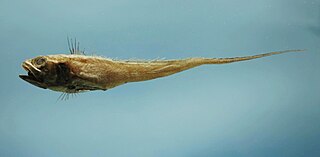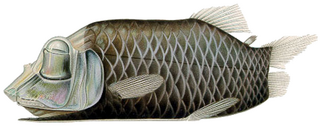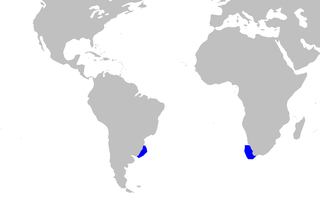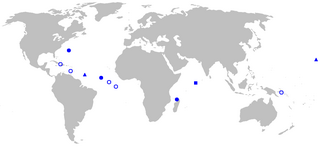
Bioluminescence is the production and emission of light by living organisms. It is a form of chemiluminescence. Bioluminescence occurs widely in marine vertebrates and invertebrates, as well as in some fungi, microorganisms including some bioluminescent bacteria, and terrestrial arthropods such as fireflies. In some animals, the light is bacteriogenic, produced by symbiotic bacteria such as those from the genus Vibrio; in others, it is autogenic, produced by the animals themselves.

Macrouridae is a family of deep sea fish, a diverse and ecologically important group, which are part of the order of cod-like fish, the Gadiformes. The species in the Macrouridae are characterised by their large heads which normally have a single barbel on the chin, projecting snouts, and slender bodies that taper to whip-like tails, without an obvious caudal fin but what there is of the caudal fin is often confluent with the posterior dorsal and anal fins. There are normally two dorsal fins, the anterior dorsal fin is quite high, the posterior quite low but is longer and takes up a greater proportion of the fish's of the back, species in the subfamily Macrouroidinae have a single dorsal fin. The long anal fin is almost as long as the second dorsal fin is nearly as long as the posterior dorsal, and sometimes it is longer. The pelvic fin is inserted in the vicinity of the thorax and normally has 5-17 fin rays but are absent in Macrouroides. The body is covered in small scales and if they have a photophore, it is usually on the midline of the abdomen just in front of the anus. The bioluminescence of these fish is produced by symbiotic bioluminescent bacteria. The structure of the skull has been used to show their placing in the Gadiformes, but they differ from the typical cods in that they possess one stout spine in the anterior dorsal fin.

A photophore is a glandular organ that appears as luminous spots on various marine animals, including fish and cephalopods. The organ can be simple, or as complex as the human eye; equipped with lenses, shutters, color filters and reflectors, however unlike an eye it is optimized to produce light, not absorb it. The bioluminescence can variously be produced from compounds during the digestion of prey, from specialized mitochondrial cells in the organism called photocytes, or, similarly, associated with symbiotic bacteria in the organism that are cultured.

Pinecone fishes are small and unusual marine fish of the family Monocentridae. The family contains just four species in two genera, one of which is monotypic. Their distribution is limited to tropical and subtropical waters of the Indo-Pacific. Pinecone fishes are popular subjects of public aquaria, but are both expensive and considered a challenge for the hobbyist to maintain.

Leftvents are small, deep-sea lophiiform fish comprising the family Linophrynidae distributed throughout tropical to subtropical waters of all oceans.

Barreleyes, also known as spook fish, are small deep-sea argentiniform fish comprising the family Opisthoproctidae found in tropical-to-temperate waters of the Atlantic, Pacific, and Indian Oceans.

The footballfish form a family, Himantolophidae, of globose, deep-sea anglerfishes found in tropical and subtropical waters of the Atlantic, Indian, and Pacific Ocean. The family contains 23 species, all of which reside in a single genus, Himantolophus.

The stoplight loosejaws are small, deep-sea dragonfishes of the genus Malacosteus, classified either within the subfamily Malacosteinae of the family Stomiidae, or in the separate family Malacosteidae. They are found worldwide, outside of the Arctic and Subantarctic, in the mesopelagic zone below a depth of 500 meters. This genus once contained three nominal species: M. niger, M. choristodactylus, and M. danae, with the validity of the latter two species being challenged by different authors at various times. In 2007, Kenaley examined over 450 stoplight loosejaw specimens and revised the genus to contain two species, M. niger and the new M. australis.

The taillight shark is a little-known species of shark in the family Dalatiidae and the only member of its genus. It is known from only four specimens collected from deep oceanic waters in the southern Atlantic Ocean and Pacific Ocean. A small shark with a laterally compressed body and a bulbous snout, this species has unusual adaptations that indicate a specialized lifestyle: its pectoral fins are paddle-like and may be used for propulsion, unlike other sharks and it has a pouch-like gland on its abdomen that emits clouds of luminescent blue fluid. This shark is likely aplacental viviparous and a formidable predator for its size.

The whitefin dogfish is a species of deep-sea dogfish shark in the family Etmopteridae. It has only been found in the northwest Pacific Ocean off the southeastern coast of Japan, between the latitudes of 35 and 32°N. It inhabits continental slopes and seamounts at a depth of 320 to 1,100 m. Reproduction is ovoviviparous. It is of no interest to fisheries and almost nothing is known of its biology. The specific epithet ritteri is in honor of Dr. William Emerson Ritter of the University of California.

The smalleye pygmy shark is a little-known species of squaliform shark in the family Dalatiidae, found in water 150–2,000 m (490–6,560 ft) deep near Japan, the Philippines, and Australia. It migrates vertically daily, spending the day in deep water and the night in shallower water. One of the smallest shark species, the smalleye pygmy shark is known to reach only 22 cm (8.7 in) long. It has a blackish, spindle-shaped body with relatively small eyes, and a spine preceding the first dorsal fin, but not the second. Bioluminescent photophores occur on its underside, which may serve to disguise its silhouette from predators. This species feeds on small squid, krill, shrimp, and bony fishes. It is aplacental viviparous. The International Union for Conservation of Nature has assessed it as Least Concern, citing its wide distribution and lack of threat from fisheries.

The fringefin lanternshark is a shark of the family Etmopteridae found in the western central Atlantic from Texas to Florida, northern Gulf of Mexico, and Mexico. It is endemic to this area. It is a deep water shark and is found about 220 to 915 meters below the surface, on the upper continental slopes of the Gulf. E. schultzi is a small shark, about 27–30 cm long and feeds on squid. It is also bioluminescent, which counter-illuminates it and helps with intraspecific interaction. Due to its limited range and the difficulty of collecting deep water species, it has not been evaluated by the IUCN Red List, but due to recent oil spills in the Gulf of Mexico, it is likely that fringefin lanternsharks have decreased in population.

The splendid lanternshark is a shark of the family Etmopteridae found in the western Pacific at depths between 120 and 210 m. Through the classification of Etmopterus species into several clades based on the positioning of their bioluminescent photophores, the splendid lanternshark can be considered a member of the Etmopterus pusillus clade.

The anglerfish are fish of the teleost order Lophiiformes. They are bony fish named for their characteristic mode of predation, in which a modified luminescent fin ray acts as a lure for other fish. The luminescence comes from symbiotic bacteria, which are thought to be acquired from seawater, that dwell in and around the sea.

Rhynchactis is a genus of deep-sea anglerfish in the family Gigantactinidae, containing three species found worldwide at depths greater than 400 m (1,300 ft). Adult female Rhynchactis reach a standard length (SL) of 11–13 cm (4.3–5.1 in) and have a dark-colored, streamlined body and a relatively small head bearing a very long illicium. Unlike almost all other deep-sea anglerfishes, the illicium bears no bioluminescent esca at the tip. The mouth is almost devoid of teeth, and the inside of both jaws are covered by numerous white glands that are unique to this genus.

Counter-illumination is a method of active camouflage seen in marine animals such as firefly squid and midshipman fish, and in military prototypes, producing light to match their backgrounds in both brightness and wavelength.

Opisthoproctus soleatus is a species of fish in the family Opisthoproctidae. It was first described in 1888 by Léon Vaillant. The species lives in most tropical seas, but is more common in the eastern Atlantic, from western Ireland to Mauritania and from Sierra Leone to Angola, and also in the South China Sea. O. soleatus can grow to a standard length of 10.5 centimetres (4.1 in) and usually live from about 500 to 700 metres deep.

Photoblepharon palpebratum, the eyelight fish or one-fin flashlightfish, is a species of saltwater anomalopid fish of the order Beryciformes. It is native to the western and central Pacific Ocean where it is found along seaward reefs close to the ocean floor, usually near rocks and corals it can use as cover. At only 12.0 cm (4.7 in) in length, it is a small fish, and more stout than other members of its family. Its body is mostly black, with a line of reflective scales running the length of its body and a distinguishing white spot at the upper corner of its preopercle. Its most notable features are its subocular bioluminescent organs which it likely uses to attract and find prey, confuse predators, and communicate with other fish. These organs are blinked on and off by the fish using a dark lid that slides up to cover them.

The splitfin flashlightfish or two-fin flashlightfish is a species of beryciform fish in the family Anomalopidae. It is found in warm waters in the central and western Pacific Ocean near shallow reefs 200–400 m (660–1,300 ft) in depth. It can grow to a length of 35 cm (14 in) TL. It is the only known member of its genus.

Neoscopelus macrolepidotus, also known as a large-scaled lantern fish, is a species of small mesopelagic or bathypelagic fish of the family Neoscopelidae, which contains six species total along three genera. The family Neoscopelidae is one of the two families of the order Myctophiformes. Neoscopelidae can be classified by the presence of an adipose fin. The presence of photophores, or light-producing organs, further classify the species into the genus Neoscopelus. N. macrolepidotus tends to be mesopelagic until the individuals become large adults, which is when they settle down to the bathypelagic zone.





















